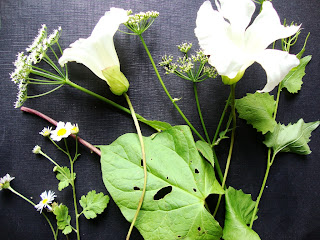Pink, red and blue weeds - one of the willowherbs, scarlet pimpernel, speedwell, forget-me-not, wild rose and bramble, herb robert and another cranesbill

Yellow and white weeds - goosegrass and ground elder, with the avens and creeping buttercup
More pink weeds - comfrey (a useful weed) and woundwort with a cranesbill
White weeds - bindweed, jack by the hedge, feverfew, ground elder
Today's weeds - enchanter's nightshade, greater hairy willowherb, tormentil, dandelion, knapweed (I introduced this), self-heal, white clover, small spurge

These are the coarsest weeds - nettle, dock, plantain and two types of borage/comfrey The process of sorting them for their photos was interesting - I found myself doing it partly by colour and partly by what kind of plant they are.
Once the weeds are in a bunch they look different - they turn into a bunch of wild flowers
And by the way, have you noticed wild flower meadows springing up all over the place? Hyde Park, the Olympic park, the raised bunds in Queen's Park, loads of unmown grass with different wild flowers in at Kew. The poppies, cornflower and corncockle have been fenced in in Hyde Park, with a warning sign (probably something to do with the Olympics)
But back to Richard Mabey's "Weeds. The Story of Outlaw Plants". The whole book is excellent, but I really enjoyed the chapter about greater celandine. Medieval herbalists recommended it to clean away "slimie things that cleave about the ball of the Eie", but as Richard Mabey says "It was a drastic remedy. The orange latex exuded by the plant is so corrosive it was also used to cauterise warts". He describes the stone carving of the plant on St Frideswide's shrine in Christ Church Cathedral, Oxford which dates from 1289. And here it is, with its characteristic lobed leaves
The carving shows a scene from the dramatic life of St Frideswide when she had to hide among vegetation to evade her pursuers (King Algar wanted to marry her so he and his band of men were chasing her). I'd say these leaves are the greater celandine... but the reason it's interesting is that as well as being the patron saint of Oxford, St Fridewide was a benefactress of the blind, which might explain the presence of the greater celandine (a "prime eye-herb", as Richard Mabey says) on her shrine.
Other plants are also beautifully carved and easy to recognise - hawthorn, mulberries (being eaten by a bird), sycamore with keys, a grape vine, ivy and oak with acorns. I mentioned the incredibly naturalistic carving to a woman replacing the flowers on the shrine and her response was "oh, they probably carved whatever was out at Port Meadow at the time". Well these days it's mainly Oxford ragwort, but it's a bit unlikely that mulberries or vines were ever there. Maybe she just thought I was being too clever. Whatever. If you're anywhere near St Frideswide's shrine go and have a look for yourself.
More incredibly detailed carved plants - this time in wood - in the chapel of Exeter College. Amazing passion flower with perfect leaves, flower and tendrils, hawthorn and vine. And outside the chapel, a passion flower growing up the wall... I love these connections
Carving skills are clearly alive and well in Oxford as I saw this butcher's display featuring carved fruit and veg in the covered market
Aren't those citrus baskets great?
And thanks for not deciding that this blog was dead. There's life in the old blog yet... more posts soon... Libraries update next.




























No comments:
Post a Comment